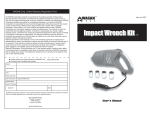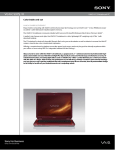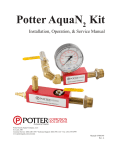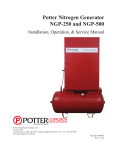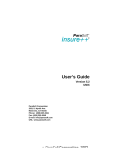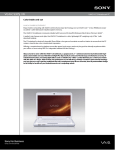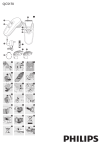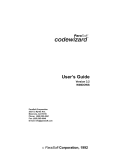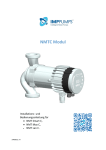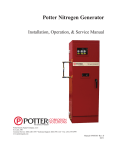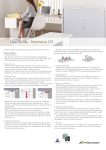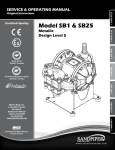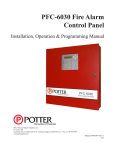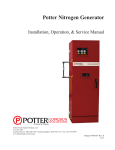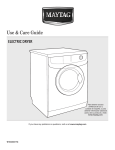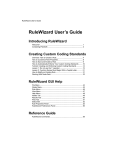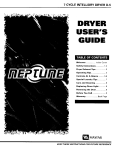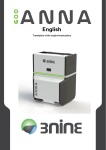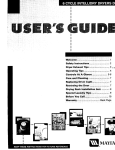Download Manual - Potter Electric Signal Company, LLC
Transcript
INS-PV Potter IntelliPurge® Nitrogen Purge Valve & INS-RA Remote Annunciator Installation, Operation, & Service Manual Potter Electric Signal Company, LLC St. Louis, MO Customer Service: (866) 240-1870 • Technical Support: (866) 956-1211 • Fax: (314) 595-6999 www.pottersignal.com/corrosion Manual #5401532 Rev. A Manual: INS-PV Table of Contents Safety..................................................................................................................................................................4 System Overview...............................................................................................................................................5 Before Going to the Job Site............................................................................................................................7 Installation of INS-PV......................................................................................................................................8 Start-Up Guide for Non-Networked INS-PV.................................................................................................9 Start-Up Guide for One INS-PV with INS-RA............................................................................................11 Start-Up Guide for Multiple INS-PVs with INS-RA...................................................................................13 Programming Using DIP switches.................................................................................................................17 Programming Using INS-RA.........................................................................................................................21 Error Codes & Trouble Shooting..................................................................................................................22 INS-PV Technical Specifications & Drawings..............................................................................................24 INS-RA Technical Specifications & Drawings..............................................................................................25 Purge Modes, Functions, and Definitions.....................................................................................................26 Wiring Diagram..............................................................................................................................................29 Warranty Policy..............................................................................................................................................30 3 Manual: INS-PV 1.Safety Safety Guidelines This manual contains safety information that is important to know and understand. This information is provided for the safety of installers, operators, and users of the Potter Nitrogen Generator as well as equipment. To help recognize this information, observe the following symbols. D Danger indicates an imminently hazardous situation which, if not avoided, WILL result in death or serious injury. Warning indicates a potentially hazardous situation which, if not avoided, COULD result in death or serious injury. Caution indicates a potentially hazardous situation which, if not avoided, MAY result in minor or moderate injury. Notice indicates important information, that if not followed may cause damage to equipment or property. Important Notice to Users The Installation and Owner’s Manual supplied with each unit must be read thoroughly and completely understood before installation and operation of the Potter Nitrogen Generator. All appropriate safety standards for handling of gases as determined by local or national laws and regulations should be followed at all times. Unpacking After unpacking unit, carefully inspect all parts and equipment for any damage that may have occurred during transit. Make sure to tighten fittings, bolts, etc. before putting unit into service. Do not operate if damage occurred during shipping, handling, or use. Contact Potter immediately. General Safety Information Important: Read all of the safety information in this manual before operating this equipment. Use of the equipment in a manner not specified within this manual may impair the protection provided by the generator and could result in an unplanned release of pressure, which may cause serious injury or damage. Only competent personnel, who have been trained, qualified, and approved by Potter Electric Signal Company, LLC should perform commissioning, servicing, and repair procedures. When handling, installing, or operating this equipment, personnel must employ safe engineering practices and observe all related local regulations, health, and safety procedures, and legal requirements for safety. Ensure that the equipment is depressurized and electrically isolated before carrying out any of the scheduled maintenance instructions specified in this manual. The warnings in this manual cover the most known potential hazards, but by definition cannot be all-inclusive. If the user employs an operating procedure, item of equipment, or a method of working that is not specifically recommended by Potter Electric Signal Company, the user must ensure that the equipment will not be damaged or become hazardous to persons or property. 4 Manual: INS-PV 2. System Overview The Potter IntelliPurge® Nitrogen Purge Valve (INS-PV) is designed to work with Potter Nitrogen Generators Systems to effectively purge corrosive oxygen from a fire sprinkler system while maintaining adequate system pressure. Potter's IntelliPurge® Nitrogen Purge Valve is the easiest way to ensure high purity nitrogen is equally distributed throughout the fire sprinkler system. Simply install the INS-PV at the end of the sprinkler system, near a 24 Volt AC/DC electrical connection. When the nitrogen generator is in operation the INS-PV bleeds out the oxygen using one of three modes that are selectable using DIP switch configuration, or by selecting the mode on the optional INS-RA Remote Annunciator. The three Purge Modes for the INS-PV include: • Perfect Purge - When the INS-PV is in Perfect Purge Mode, the unit purges the air out of the system until 98% N2 purity is reached. This mode is the unit's default setting. • Single Shot - In this mode, a Purge Time is selected and the valve automatically shuts off after that time expires. • IntelliDry - This mode is designed for freezers or ice plug applications. After the system reaches 98% purity, it will cyclically open and close. This allows any excess, trapped moisture to be periodically purged, while still lowering the duty cycle at the compressor. • For additional information on Purge Modes, see page 26. In the event of a system activation, the INS-PV has a built in high pressure water shut-off valve that automatically closes when the water reaches the vent. A ball valve allows for isolation of the assembly, maintenance of strainer screen, replacement of air vent, or maintenance of the purge orifice. See Figure 1 for INS-PV System Diagram. Figure 1: INS-PV System Diagram 20 1/2" PIPE FROM SPRINKLER SYSTEM INTELLIPURGE ORIFICE 7 1/8" UNION VENT INS-PV 7 1/4" 1/2" NPT TEE CONNECTION AND CLOSED NIPPLE (SUPPLIED BY SPRINKLER CONTRACTOR) UNION - POSITION VENT/ORIFICE/INS-PV APPROPRIATELY PURGE BALL VALVE, SHOWN IN NORMALLY CLOSED (NON-PURGE) POSITION INSPECTORS TEST VALVE 5 Manual: INS-PV Figure 2: Typical INS-PV External View Slotted Cam Latch N2 Level % Display Power LED S1 Toggle Switch S2 Toggle Switch Purge LED Trouble LED Purge Time Display Purge Exhaust Port See Definitions on page 27 for further information. 6 Manual: INS-PV 3. Before Going To The Jobsite 1. On arrival, do a full inspection by checking all packages and crates in the shipment for damage. If damage is found, sign for the damage or refuse the shipment. Contact the carrier immediately and file a shipping damage claim with the carrier. 2. Check to ensure all components are contained and no visible damage has occurred during shipping. Check List: INS-PV Vent Optional INS-RA MFG# 1119478 MFG# 1119478 Optional Transformer (PV) MFG# 1119476 Optional Transformer (RA) MFG# 5270462 MFG# 5270463 Important: Read all of the safety information in this manual before installing or operating this equipment. 3. Find a location to install the INS-PV that meets these requirements: Access to front and top for maintenance Conveniently located near power requirements (24 Volt AC/DC) Dimensions for INS-PV 7.3” x 6.8” x 7.9” (H x W x D) Dry, clean, and well-ventilated Ambient temperatures between -4°F (-20°C) and 122°F (50°C) The INS-PV should always be installed in an adequately ventilated room. Nitrogen is nontoxic and largely inert. Rapid release of nitrogen gas into an enclosed space displaces the oxygen and can cause an asphyxiation hazard. Inhalation of nitrogen in excessive concentrations can result in unconsciousness without any warning symptoms. 4. Find a location to install the INS-RA that meets these requirements: Conveniently located near power requirements (24 Volt DC) INS-RA conveniently located for system monitoring Dimensions for INS-RA 7.8" x 10" x 1.7" (H x W x D) Ambient temperatures between 32°F (0°C) and 120°F (49°C) 5. All wire connections must be made with 14-22 AWG stranded wire. NOTE: Solid core wire is not recommended. 6. Run a 24 Volt AC/DC wire to installation location for INS-PV and run a 24 Volt DC wire to location for INS-RA. NOTE: Class 2 Transformers available for 120 V application. Wire gage must be considered when running power for long distances to the INS-PV. Refer to Figure 3. 7. Maximum wire length for network is 6500 ft. Maximum number of INS-PV devices on network is 27. Maximum number of INS-RA devices on network is 4. 7 Figure 3 MINIMUM AWG 22 20 18 16 14 FT. <40 <70 <100 <160 <300 Manual: INS-PV 4. Installation of INS-PV 1. Read and understand the instructions provided before proceeding with installation. The INS-PV shall be installed in accordance with local ordinances and the applicable NFPA 13, NFPA 13D, or NFPA 13R standard. Figure 4 2. The Engineer of Record should select the INS-PV installation location. This is usually located at the end point of the system, be sure that location is accessible and is near 24 Volt AC/DC wiring connection. 3. The unit must be level and arranged in such a manner that water will not become trapped. Trapped water could cause the INS-PV not to purge. 4. Install vent to 1/2" NPT connection off sprinkler system. See Figure 4. Vent must be installed in level, horizontal position Figure 5 5. Install INS-PV to vent using union and position for easy access. See Figure 5. Figure 6 6. After installation, close ball valve prior to hydrostatic tests. See Figure 6. 8 Manual: INS-PV 5. Start Up Guide for Non-Networked INS-PV NOTES: • All INS-PV units are factory set in Perfect Purge mode for sprinkler systems with a volume less than 500 gallons. For additional purge configurations, see Programming Guide, starting on page 17. • Wiring of the INS-PV unit for both Power and BMS notification should be done before starting the purge process. See Wiring Diagram on page 29. Figure 7 1. Before applying power to the INS-PV, open the INSPV door and observe the DIP switches located on the printed circuit board. On the S2 Switch, verify the DIP switches 4, 5, 6, 7 and 8 are in the OFF position,as seen in Figure 7. 2. If the INS-PV unit is installed at an elevation higher than 3,000 FT above sea level, please review the Programming Guide on page 18 for Elevation Settings. 3. After confirming the DIP switches are configured correctly, close the INS-PV door. 4. Apply power to the INS-PV unit. The Power LED indicator should display a solid green LED. If not, the INS-PV is not powered ON. Check wiring of INS-PV unit. 5. If the INS-PV is powered on for the first time, there will be a 5 minute delay when the nitrogen sensor is calibrating. During this time the Start Purge Button can be pressed and the device will appear to start a purge cycle, but it will not cause the device to begin purging until after calibration. If the trouble LED indicator blinks red and “Er” then “01” blinks on the Purge Time display, there was an error during calibration. Go to Troubleshooting Guide on page 22. 6. After a successful calibration, the INS-PV unit is ready for operation. 7. To start the purging process, toggle the S1 switch into the Start Purge mode. 8. Once the purge process has started, the yellow Purge LED indicator will begin blinking. 9. The Purge Time display will display the max number of purge days, which is the maximum amount of time the unit is allowed to purge before indicating a trouble. 10. The N2 Level display will blink indicating that it is taking an initial nitrogen level reading. After five minutes the N2 Level display should read ambient nitrogen levels, between 78-81%. 11. The INS-PV is now purging. The oxygenated air is escaping out of the Purge Exhaust Port. 12. The INS-PV unit will take a nitrogen level reading every two hours. This will be indicated by the N2 Level display blinking the last reading and subsequently displaying the nitrogen level purity in the sprinkler system. 13. When the INS-PV reads greater than 98% N2 level for multiple consecutive readings, the INS-PV will close the solenoid valves and stop purging. 14. After the INS-PV unit has closed the solenoid valves and stopped purging, the unit will continue to take nitrogen purity samples from the fire sprinkler system. This is to ensure that the entire fire sprinkler system has equilibrated to 98% throughout the piping. 9 Manual: INS-PV 15. When the INS-PV unit has confirmed that the fire sprinkler system is greater than 98% N2 level, the purge process will be considered successful and the INS-PV valve will remain closed. 16. The yellow Purge LED indicator will turn solid. The Purge Time display will go blank. 18. The INS-PV will continue to monitor the nitrogen purity level of the fire sprinkler system. If the N2 level % drops below 98% for any one reading, the INS-PV will go into trouble, illuminate the red Trouble LED indicator, and blink “Er” “08” Error Code on the Purge Time display. For troubleshooting and Error Code definitions see Troubleshooting Guide on page 22. 10 Manual: INS-PV 6. Start Up Guide for One INS-PV With INS-RA NOTES: • All INS-PV units when connected to an INS-RA maintain their purge mode, all INS-PV DIP switches are factory set to perfect purge mode for system volume less that 500 gallons. For additional purge configurations, see Programming Guide starting on page 17. • Wiring of the INS-PV unit for Power, to the INS-RA and BMS notification, should be done before starting the purge process. See Wiring Diagram on page 29. • For additional functionality such as setting date and time, viewing history, etc., see page 26. Figure 8 1. Before applying power to the INS-PV, open the INSPV door and observe the DIP switches located on the printed circuit board. On the S2 switch, move DIP switch 8 to the ON position, as seen in Figure 8. 2. If the INS-PV unit is installed at an elevation higher than 3,000 FT above sea level, please review the Programming Guide for Elevation Settings on page 18. 3. After confirming the DIP switches are configured correctly, close the INS-PV door. 4. Apply power to the INS-PV unit. The Power LED indicator should display a solid green LED. If not, the INS-PV is not powered ON. Check wiring of INS-PV unit. 5. If the INS-PV is powered on for the first time, there will be a 5 minute delay while the nitrogen sensor is calibrating. If the trouble LED indicator turns solid red and “Er” then “01” blinks on the Purge Time display, there was an error during calibration. Go to Troubleshooting Guide on page 22. 6. After a successful calibration, the INS-PV unit is ready for operation. 7. Go to the INS-RA unit and open the door. Detach the front panel by removing the two screws located at the top and bottom of the cover. Figure 9 8. Confirm that the INS-RA DIP switches are configured with 1 and 2 in the OFF position and 3, 4 and 5 in the ON position. See Figure 9. 9. Apply power to the INS-RA. NOTE: Once the INS-RA is powered ON and connected to an INS-PV, the INS-RA maintains the purge mode established by the DIP switches on the INS-PV. Figure 10 10.Wait for the INS-RA to display the Title Screen. See Figure 10. NOTE: If Trouble No Communication is displayed, INS-PV and INS-RA are not wired correctly. See Troubleshooting Guide on page 22. 11.Press ENTER on the INS-RA keypad. Figure 11 12. There will be 5 menu options displayed on the INS-RA: 1) System Status, 2) View History, 3) Start Purge, 4) Cancel Purge, and 5) Settings. See Figure 11. 11 Manual: INS-PV 13.Select Start Purge by either selecting it using the number on the keypad (3), or moving the cursor to the number 3 using the directional pad and pressing ENTER on the INS-RA. 14. The INS-RA will prompt you with a passcode. Enter the passcode 0000. Figure 12 15. The INS-RA will then display a screen with the options of 1) All Devices or 2) Specify Devices. Seen in Figure 12. 16. Since there is only one INS-PV connected to the INS-RA, either All Devices or Specify Device options will work. For start up with additional INS-PVs see Start up Guide for Multiple INS-PVs and INS-RA on page 13. Select either option and press ENTER. The INS-RA will display devices found. 17.Press ENTER to start purge cycle. The INS-PV is now purging. 18. Return to the Main Menu by pressing ESC. 19. Select option 1) System Status on the main menu. Figure 13 20. The System Status should populate: Device, N2 Level, Days Remaining, Purge Mode, Purge Status, as seen in Figure 13. 21.N2 Level % will display the last recorded measurement. If the N2 Lvl % indicates “- -“ the INS-PV has not completed its initial measurement. Readings take 5 minutes to complete. Refresh the screen by pressing ESC and then reselecting 1) System Status. 22. Concurrently at the INS-PV unit, the yellow Purge LED indicator will begin to blink. The Purge Time display will display days remaining, and the N2 Level display will begin to blink indicating that it is taking an initial nitrogen level reading. 23. The INS-PV unit takes a nitrogen level reading every two hours. This is indicated by the N2 Level display blinking on the INS-PV unit and subsequently displaying the nitrogen level purity in the sprinkler system. 24. The nitrogen level will also update on the INS-RA under the system status. This gives a higher degree of resolution (1/10 of a percent). 25. When the INS-PV nitrogen sensor reads greater than 98% N2 level for multiple consecutive readings, the INS-PV will close the solenoid valves and stop purging. 26. After the INS-PV unit has stopped purging, the unit will continue to take nitrogen purity samples from the fire sprinkler system. This is to ensure that the entire fire sprinkler system has equilibrated to 98% N2 level throughout the piping. 27. When the INS-PV unit has confirmed that the fire sprinkler system is greater than 98% N2 level, the purge process will be considered successful and the INS-PV valve will remain closed. 28. The INS-RA will display the Purging Status under System Status Menu. If the system has successfully purged, the INS-RA display will indicate “Success” and the Days Remaining will indicate zero. 29. At the INS-PV, the yellow Purge LED indicator will turn solid and the Purge Time display will go blank. 12 Manual: INS-PV 7. Start Up Guide Multiple INS-PVs With INS-RA NOTES: • All INS-PV units when connected to an INS-RA maintain their purge mode, all INS-PV DIP switches are factory set to perfect purge mode for a system volume of 500 gallons or less. For additional purge configurations, see Programming Guide starting on page 17. • Wiring of all the INS-PV units for Power to the INS-RA and for BMS notification should be done before starting the purge process. See Wiring Diagram on page 29. • When connecting multiple INS-PVs in a networked configuration each INS-PV unit must have a defined address. Each network can handle up to (27) INS-PV units and (4) INS-RA units. • Networked INS-PV units work on a master and slave type addressing system. One and only one INS-PV can be defined as the Master INS-PV. All other INS-PV units must be addressed as different units using DIP switches on the printed circuit board. If you have more than one INS-PV on the same address, communication problems will occur. • The first INS-PV device in the network must be programmed as INS-PV-1. • The final INS-PV device in the network must be programmed as INS-PV-27. This device should only have wiring from the previous device and no outgoing wiring from PLink 2. • For additional functionality such as setting date and time, viewing history etc., see page 26. 1. Before powering ON any of the INS-PV units, each unit must be assigned a specific unique address. 2. Open the door of the first INS-PV unit in the network. This will be the INS-PV unit wired to the INS-RA. 3. Before applying power to the INS-PV, open the INSPV door and observe the DIP switches located on the printed circuit board. On the S2 switch, move DIP switch 8 to the ON position, as seen in Figure 14. Figure 14 4. If the INS-PV unit is installed at an elevation higher than 3,000 FT above sea level, please review the Programming Guide for Elevation Settings on page 18. 5. Record the location of the INS-PV on the DIP switch Address Configuration Table on page 19. After confirming that the DIP switches are configured correctly, close the INS-PV door. 6. Apply power to the INS-PV unit. The Power LED indicator should display a solid green LED. If not, the INS-PV is not powered ON. Check wiring of INS-PV unit. 7. If the INS-PV is powered on for the first time, there will be a 5 minute delay when the nitrogen sensor is calibrating. During this time the Start Purge Button can be pressed and the device will appear to start a purge cycle, but it will not cause the device to begin purging until after calibration. If the trouble LED indicator blinks red and “Er” then “01” blinks on the Purge Time display, there was an error during calibration. Go to Troubleshooting Guide on page 22. 8. After a successful calibration, the INS-PV unit is ready for operation. Go to the next INS-PV unit in the network. Open the INS-PV door. 13 Manual: INS-PV Figure 15 9. Before applying power to the INS-PV, open the INSPV door and observe the DIP switches located on the printed circuit board. On the S2 switch, move DIP switch 7 to the ON position, as seen in Figure 15. 10. If the INS-PV unit is installed at an elevation higher than 3,000 FT above sea level, please review the Programming Guide for Elevation Setting on page 18. 11. Record the location of the INS-PV on the DIP switch Address Configuration Table on page 19. After confirming that the DIP switches are configured correctly, close the INS-PV door. 12. Apply power to the INS-PV unit. The Power LED indicator should display a solid green LED. If not, the INS-PV is not powered ON. Check wiring of INS-PV unit. 13. If the INS-PV is powered on for the first time, there will be a 5 minute delay when the nitrogen sensor is calibrating. During this time the Start Purge Button can be pressed and the device will appear to start a purge cycle, but it will not cause the device to begin purging until after calibration. If the trouble LED indicator blinks red and “Er” then “01” blinks on the Purge Time display, there was an error during calibration. Go to Troubleshooting Guide on page 22. 14. After a successful calibration, the INS-PV unit is ready for operation. 15. Repeat steps 9 to 14, making sure to change each address until all INS-PV units have been uniquely addressed. 16. Record each INS-PV unit, its address and its location on the DIP switch Address Configuration Table on page 19. This will help locate which unit is signaling a trouble in the case of a fault. 17. Double check to ensure that none of the INS-PV units have the same address. This will cause communication errors. NOTE: Your last INS-PV unit must be addressed as INS-PV-27. 18. Go to the INS-RA unit and open the door. Detach the front panel by removing the two screws located at the top and bottom of the cover. Figure 16 19. Confirm that the INS-RA DIP switches are configured with 1 and 2 in the OFF position and 3, 4 and 5 in the ON position. See Figure 16. 20. Apply power to the INS-RA. NOTE: Once the INS-RA is powered ON and connected to an INS-PV, the INS-RA maintains the purge mode established by the DIP switches on the INS-PV. Figure 17 21.The INS-RA should display the Title Screen. See Figure 17. NOTE: If Trouble No Communication is displayed, INS-PV and INS-RA are not wired correctly. See Troubleshooting Guide on page 22. 22.Press ENTER on the INS-RA keypad. Figure 18 23. There will be 5 menu options displayed on the INSRA: 1) System Status, 2) View History, 3) Start Purge, 4) Cancel Purge, and 5) Settings. See Figure 18. 14 Manual: INS-PV 24.Select Settings by either selecting it using the number on the keypad (5), or moving the cursor to the number 5 using the directional pad and pressing enter on the INS-RA. 25. The INS-RA will prompt you with a password. Enter the password 0000. Figure 19 26. The INS-RA Menu will display 1) Learn Network, 2) Purge Settings, 3) Manual Purge, 4) Refresh N2 %, 5) Clear History, 6) Set Date/Time. See Figure 19. 27.Select Learn Network and press ENTER. The Master INS-PV will begin searching for all INS-PV units on the PLink or INS network. Figure 20 28. The INS-RA will display 1) PLink Found and 2) PLink Removed. See Figure 20. 29.Select 1) PLink Found and scroll through the list of new INS-PV units found by moving up and down on the directional pad. 30. Check to ensure all INS-PV units on the DIP switch Address Configuration Table (page 19) match up with all new INS-PV units added to the network. 31.Select 2) PLink Removed. 32. If there is a missing, unfound, or removed INS-PV unit, return to the location of the unfound INS-PV unit and recheck S2 switch DIP switch addresses. 33.Press ESC. Press 1 to accept changes. Press ENTER to confirm changes. 34. INS-RA and INS-PV will reset. The INS-RA will re-initialize to the Title Menu. Press ENTER. 35.Select 3) Start Purge and enter pass code 0000. 36. The INS-RA will then display a screen with the options of 1) All Devices or 2) Specify Device. See Figure 21. Figure 21 37. To purge all INS-PV units connected to the network, select All Devices option and press ENTER. To purge individual fire sprinkler systems, select Specify Device. 38. When Specify Device is selected, select which INS-PV unit to purge by scrolling through the list of INS-PV units by pressing up or down on the directional pad. Figure 22 39. The INS-RA will display a confirm screen. The INSPV units selected are now purging. See Figure 22. 40. Return to the Main Menu by pressing ESC. 15 Manual: INS-PV 41. Select option 1) System Status on the Main Menu. Figure 23 42. The System Status should populate: Device, N2 Level %, Days Remaining, Purge Mode, Purge Status, as seen in Figure 23. 43.N2 Level % will display the last recorded measurement. If the N2 Lvl % indicates “- -“ the INS-PV has not completed its initial measurement. Readings take 5 minutes to complete. Refresh the screen by pressing ESC and then reselecting 1) System Status. 44. Scroll through the INS-PV units by using the up and down arrows on the directional pad of INS-RA. All INS-PV units on the network should be displayed in system status. 45. The INS-PV units that were selected to purge will continue purging until their nitrogen sensors read greater than 98% N2 Level for multiple consecutive readings. Those INS-PVs will then stop purging. NOTE: Purging times vary depending on system size and configuration. When multiple INS-PV units are networked in Perfect Purge mode, individual systems could reach 98% N2 Level at different times. This is normal. 46. After the INS-PV unit has stopped purging, the unit will continue to take nitrogen purity samples from the fire sprinkler system. This is to ensure that the entire fire sprinkler system has equilibrated to 98% N2 Level throughout the piping. 47. When the INS-PV unit has confirmed that the fire sprinkler system is greater than 98% N2 level, the purge process will be considered successful and the INS-PV valve will remain closed. 48. The INS-RA will display the Purge Status under System Status Menu. If the system has successfully purged, it will indicate “Success” and the remaining Days will go blank. 49. At the INS-PV, the yellow Purge LED indicator will turn solid and the Purge Time display will go blank. After all INS-PV units have completed the purging process, the systems are now protected. 16 Manual: INS-PV 8. Programming Using DIP switches 1. DIP switches are located at the bottom left corner of the circuit board when the cabinet is open. See Figure 24. Figure 24 2. DIP switches 1 and 2 on the "S1" Switch will control the Mode of the INS-PV. SW 1 SW 2 Purge Mode SW 1 Off Off On SW 2 Off On Off Definition Perfect Purge Mode IntelliDry Mode Single Shot Mode 17 Manual: INS-PV 3. DIP switches 3,4,5, and 6 on the "S1" Switch will control the way in which the INS-PV behaves within the parameters of the selected mode. SW 3 SW 5 SW 4 SW 3 SW 4 Off Off Off On On Off On On SW 5 Off Off On On SW 6 Off On Off On 4. SW 6 Purge Cycle Settings Perfect Purge IntelliDry 500 gallon systems and 500 gallon systems and smaller smaller Systems ranging from 500 Systems ranging from 500 to 1000 gallons to 1000 gallons Systems that are 1000 Systems that are 1000 gallons or greater gallons or greater Reserved Reserved Dryness Level for IntelliDry Perfect Purge IntelliDry Unused Low Dryness Unused Medium Dryness Unused High Dryness Reserved Reserved Single Shot Purge for 14 days then turn off indefinitely Purge for 21 days then turn off indefinitely Purge for 30 days then turn off indefinitely Reserved DIP switches 7 and 8 on the "S1" Switch will be adjusted according to elevation. SW 7 SW 8 Elevation Settings SW 7 Off Off On On 5. SW 8 Off On Off On Elevation Below 3000 ft. 3000 ft. to 8000 ft. 8000 ft. to 12000 ft. Reserved For local device, DIP switches 4,5,6,7, and 8 on the "S2" Switch are in the OFF position. Local INS-PV SW 4 SW 6 SW 5 18 SW 8 SW 7 Single Shot Unused Unused Unused Reserved Manual: INS-PV 6. DIP switch Address Configuration for Networked INS-PVs. Example: Name DIP switch Configuration = ON OFF 1 Location 2 3 5 6 7 DIP switch Configuration Name INS-PV-1 (Master) INS-PV-2 (Slave) INS-PV-3 (Slave) INS-PV-4 (Slave) INS-PV-5 (Slave) INS-PV-6 (Slave) INS-PV-7 (Slave) INS-PV-8 (Slave) INS-PV-9 (Slave) INS-PV-10 (Slave) INS-PV-11 (Slave) INS-PV-12 (Slave) INS-PV-13 (Slave) INS-PV-14 (Slave) 4 8 Location INS-PV-15 (Slave) INS-PV-16 (Slave) INS-PV-17 (Slave) INS-PV-18 (Slave) INS-PV-19 (Slave) INS-PV-20 (Slave) INS-PV-21 (Slave) INS-PV-22 (Slave) INS-PV-23 (Slave) INS-PV-24 (Slave) INS-PV-25 (Slave) INS-PV-26 (Slave) * INS-PV-27 (Slave) *NOTE: Regardless of the number of INS-PV units installed on the sprinkler system, the final unit on the network of INS-PV units must be addressed as number 27. This means that even if there are only two units installed, the second unit must be addressed as INS-PV-27. 19 Manual: INS-PV 7. DIP switch Address Configuration for INS-RAs. Example: = Name ON OFF 1 DIP switch Configuration INS-RA-28 INS-RA-29 INS-RA-30 INS-RA-31 20 2 3 4 5 Location Manual: INS-PV 9. Programming Using INS-RA To program the INS-PV using the INS-RA, follow the Programming Tree. Figure 25: Programming Tree MAIN MENU 1=System Status 2=View History System Status: •Device Address •N2 % Level •Days Remaining •Purge Mode •Status 3=Start Purge 4=Cancel Purge 5=Settings Password Required Password Required Password Required 2=Select INS-PV Device 1=All Devices 1=All Devices Viewable Parameters: 1=Trouble Status 2=Sensor Status Trouble Status: •Device Address •Error Code •Error Description Only troubled units 1=Learn Network 1= Scrollable list of all events in “first in/first out” logging system. Select Purge Mode 2=Specify Device 2=Specify Device by using arrow keys Sensor Status: •Device Address •Status For all units 2=Purge Settings Searching for new INS-PV devices & INS-RA devices to add them to the network. 1=All Devices 2=Individual INS-PV 3=Manual Purge 1=All Devices 3=Purge Schedule Maximum number of INS-PVs that can purge at one time. System Size 4=Refresh N2 % 2=Specify Device 4=Reset Defaults 1=All Devices 1=All Devices 2=Specify Device To view updated N2 Level %, wait 5 minutes and return to “Main Menu” then select “System Status”. Select Purge Mode System Size 21 6=Set Date & Time 5=Clear History 2=Specify Device Change date and time on all INS-PV devices Manual: INS-PV 10.Error Codes & Troubleshooting Code Meaning Corrective Actions 1. If the initial N2 Sensor Test fails, the unit will continue to retest. Wait for 10 minutes. 2. 3. Press the Start Purge button again to clear the error code. If the Er 1 comes back on the display within ten seconds, check the DIP switch configuration to ensure the elevation setting is correct for your sea level. RED BLK BLK PNK Check to ensure the sensor cable is plugged in correctly (See Graphic). 4. 01 Initial N2 Sensor Test Failed 5. 02 6. Check to ensure the INS-PV is not currently connected to a fire sprinkler system that is already above ambient conditions. Isolate the INS-PV unit using the ball valve. Wait 2 hours and return to press the Start Purge button. Contact Potter technical support if error code returns. 1. 2. 3. If the N2 Sensor Test fails, the unit will continue to retest. Check the DIP switch configuration to ensure the elevation setting is correct for your elevation. RED BLK BLK PNK Check to ensure the sensor cable is plugged in correctly (See Graphic). 4. 5. Check to ensure the INS-PV is not currently connected to a fire sprinkler system that is already above ambient conditions. Isolate the INS-PV unit using the ball valve. Wait 2 hours and return to see if error code has cleared. Contact Potter technical support if error code remains. 1. Check the N2 level % at the INS-PV (or INS-RA). 2. If the N2 level % is below 82%: Subsequent N2 Sensor Test Failed • Check to ensure that ball valve is open to the INS-PV unit. If ball valve is closed the INS-PV cannot sense the nitrogen in the system. Open the ball valve and press Refresh N2 on the INS-PV. 03 Low N2 measured upon completion of Single Shot purge cycle • Ensure the Nitrogen Generator is in Nitrogen Generating Mode. This can be checked by using a portable nitrogen analyzer. The N2 level % leaving the membrane should be 98% or greater. Note: The nitrogen generator needs to be running for accurate nitrogen reading. Call technical support if nitrogen leaving membrane is not 98% or greater. 3. If the N2 level % is above 90%: • Check the DIP switch configuration for the sprinkler system. Ensure the correct size sprinkler system setting was selected for unit. See Programming Guide for configuration. The purge process may need to be repeated. • Ensure the Nitrogen Generator is in Nitrogen Generating Mode. This can be checked by using a portable nitrogen analyzer. The N2 level % leaving the membrane should be 98% or greater. Note the nitrogen generator needs to be running for accurate nitrogen reading. Call technical support if nitrogen leaving membrane is not 98% or greater. The INS-PV measured nitrogen level below 98%: 04 Low N2 measured after Single Shot purge cycle completed successfully • Check to ensure that ball valve between INS-PV and sprinkler system is open. • Ensure the Nitrogen Generator is in Nitrogen Generating Mode. This can be checked by using a portable nitrogen analyzer. The N2 level % leaving the membrane should be 98% or greater. Note the nitrogen generator needs to be running for accurate nitrogen reading. Call technical support if nitrogen leaving membrane is not 98% or greater. 22 Manual: INS-PV Code Meaning Corrective Actions 1. Check the N2 level % at the INS-PV (or INS-RA). 2. If the N2 level % is below 82%: • Check to ensure that ball valve is open to INS-PV unit. If ball valve is closed INS-PV cannot sense the nitrogen in the system. Open ball valve and press Refresh N2 on the INS-PV. 05 Low N2 measured upon completion of initial IntelliDry purge cycle • Ensure the Nitrogen Generator is in Nitrogen Generating Mode. This can be checked by using a portable nitrogen analyzer. The N2 level % leaving the membrane should be 98% or greater. Note the nitrogen generator needs to be running for accurate nitrogen reading. Call technical support if nitrogen leaving membrane is not 98% or greater. 3. If the N2 level % is above 90%: • Check the DIP switch configuration for the sprinkler system. Ensure the correct size sprinkler system setting was selected for unit. See Programming Guide for configuration. The purge process may need to be repeated. • Ensure the Nitrogen Generator is in Nitrogen Generating Mode. This can be checked by using a portable nitrogen analyzer. The N2 level % leaving the membrane should be 98% or greater. Note the nitrogen generator needs to be running for accurate nitrogen reading. Call technical support if nitrogen leaving membrane is not 98% or greater. The INS-PV measured nitrogen level below 98%. 06 • Check to ensure that ball valve between INS-PV and sprinkler system is open. Low N2 measured after initial IntelliDry purge cycle completed successfully • Ensure the Nitrogen Generator is in Nitrogen Generating Mode. This can be checked by using a portable nitrogen analyzer. The N2 level % leaving the membrane should be 98% or greater. Note the nitrogen generator needs to be running for accurate nitrogen reading. Call technical support if nitrogen leaving membrane is not 98% or greater. 1. Check the N2 level % at the INS-PV (or INS-RA). 2. If the N2 level % is below 82%: • Check to ensure that ball valve is open to INS-PV unit. If ball valve is closed INS-PV cannot sense the nitrogen in the system. Open ball valve and press Refresh N2 on the INS-PV. 07 Low N2 measured upon completion of initial Perfect Purge purge cycle • Ensure the Nitrogen Generator is in Nitrogen Generating Mode. This can be checked by using a portable nitrogen analyzer. The N2 level % leaving the membrane should be 98% or greater. Note the nitrogen generator needs to be running for accurate nitrogen reading. Call technical support if nitrogen leaving membrane is not 98% or greater. 3. If the N2 level % is above 90%: • Check the DIP switch configuration for the sprinkler system. Ensure the correct size sprinkler system setting was selected for unit. See Programming Guide for configuration. The purge process may need to be repeated. • Ensure the Nitrogen Generator is in Nitrogen Generating Mode. This can be checked by using a portable nitrogen analyzer. The N2 level % leaving the membrane should be 98% or greater. Note the nitrogen generator needs to be running for accurate nitrogen reading. Call technical support if nitrogen leaving membrane is not 98% or greater. The INS-PV measured nitrogen level below 98%. 08 Low N2 measured after initial Perfect Purge purge cycle completed 09 Low N2 measured before a purge cycle has been started 10 Device Fault 11 Communication Error • Check to ensure that ball valve between INS-PV and sprinkler system is open. • Ensure the Nitrogen Generator is in Nitrogen Generating Mode. This can be checked by using a portable nitrogen analyzer. The N2 level % leaving the membrane should be 98% or greater. Note the nitrogen generator needs to be running for accurate nitrogen reading. Call technical support if nitrogen leaving membrane is not 98% or greater. 1. This error indicates the unit has measured a nitrogen level below 98% while not being in or having completed a successful purge cycle, and the fire sprinkler system is not at 98% Nitrogen. 2. Start a purge process by pressing the “Start Purge” switch on the INS-PV or by using the INS-RA. Check for short circuits on wires connected to connectors E2 and E3 on the Printed Circuit Board. The INS-PV Master is not communicating to one or more of it's slave devices: • View "System Status", look for missing INS-PV devices. • Once identified, verify that device has power and the communication lines are connected appropriately. 23 Manual: INS-PV 11.INS-PV Technical Specifications and Drawings INS-PV Specifications 24 Volt AC/DC, 1.5 A -4°F-122°F (-20°C-50°C) 10%-93% @ 86ºF (30ºC) non-condensing humidity Maximum air pressure entering INS-PV must not exceed 100 PSI 27 6500 ft. 7.3” x 6.8” x 7.9” 14 AWG-22AWG Power Requirements Operating Temperature Range Operating Pressure Maximum INS-PVs (Networked) Maximum Wire Length (Network) Size (WxHxD) Wire Gauge Figure 26: INS-PV Dimensions 8 Front6 View 7 4 5 14.65in 372.21mm 8 7 14.65in 372.21mm 1/2" BALL VALVE SYSTEM ISOLATION VALVE FOR INSTALLATION AND MAINTENANCE B 8 D 6.88in 6 174.70mm 7 2.57in 1/2" BALL VALVE SYSTEM ISOLATION VALVE 65.21mm FOR INSTALLATION AND MAINTENANCE .875in 22.23mm ELECTRICAL KNOCKOUTS 1/2" Y-TYPE #40 MESH STRAINER FOR 1/2" CONDUIT CONNECTION 3 PLCS Side View 4.80in 4 3 2 372.21mm 2.57in 65.21mm 199.64mm 186.94mm ALL DIMENSIONS FOR REFERENCE ONLY 1.06in 26.92mm 1.33in 33.84mm9.83in 2.18in 11.82in 55.38mm 300.34mm 1.15in 29.08mm 7 1/2" BALL VALVE SYSTEM ISOLATION VALVE FOR INSTALLATION AND MAINTENANCE 87.13mm BACK VIEW 7 6 5 1.57in 39.81mm 2.57in 65.21mm DO NOT SCALE DRAWING .XX = ±.015 CAD GENERATED DRAWING, DO NOT MANUALLY UPDATE 4.80in 4 DECIMALS 121.92mm .XX = ±.015 INTELLIPURGE VALVE (OUTLINE DRAWING) 3 ANGLES ±1° .XXX = ±.005 SIZE 7.36in DATE 8-7-2014 B 186.94mm APPROVALS DRAWN DWG. NO. -- NWD CHECKED 3 -- 2 8-7-2014 24 DATE 8-7-201 NWD CHECKED TOLERANCES UNLESS SPECIFIED SCALE 1:4 SHEET 1 OF 1 .XX = INCH [XX.XX] = MILLIMETERS 7.45in 189.17mm ±1° APPROVALS DRAWN TITLE DO NOT SCALE DRAWING 5 .875in 22.23mm ELECTRICAL KNOCKOUTS FOR 1/2" CONDUIT CONNECTION 3 PLCS4 POTTER E VENDOR CERTIFICATION VENDOR CERTIFIES ALL PARTS SUPPLIED FROM THIS DRAWING HAVE BEEN PRODUCED CAD TO GENERATED DRAWING ITS SPECIFICATIONS AND VENDOR WILL BE RESPONSIBLE FOR ANY REWORK COST WHERE DO NOT MANUALLY UPDA SPECIFICATIONS HAVE NOT BEEN MET. .XXX = ±.005 POTTER ELECTRIC SIGNAL CO. A 87.13mm 6 DATA CONTAINED HEREIN OR PART OUTSIDE POTTER E TOLERANCES UNLESS SPECIFIE DATA CONTAINED HEREIN SHALL NOT BE USED, DUPLICATED OR DISCLOSED IN WHOLE C OR PART OUTSIDE POTTER ELECTRIC, INC. WITHOUT WRITTEN PERMISSION OF SAME. DECIMALS ANGLE 2.18in 1/2" Y-TYPE #40 MESH STRAINER BACK VIEW 55.38mm 6.88in 174.70mm 3.43in B VENDOR CERTIFIES ALL PAR ITS SPECIFICATIONS AND V SPECIFICATIONS HAVE NO PROPRIETARY DATA UNION POSITION VENT/ORIFICE APPROPRIATELY 3.43in 1.33in 33.84mm D 202.58mm 249.59mm B 1 121.92mm ALL DIMENSIONS FOR REFERENCE 7.98inONLY A 8 7 186 = INCH [XX.XX] = MILLIMETERS 7.45in 189.17mm 4.80i 121.92m .XX = INCH [XX.XX]7.36in = MILLIMETERS 7.86in .875in 22.23mm PURGE ORIFICE ELECTRICAL KNOCKOUTS 7.45in FOR 1/2" CONDUIT CONNECTION 189.17mm 3 PLCS 6.85in 173.95mm 1/4" BARBED HOSE CONNECTION EXHAUST/CONDENSATION OUTLET 8 1.57in 39.81mm C UL LISTED PURGE VALVE FOR FIRE SPRINKLER BRANCH LINE .XX APPLICATIONS. C D 1/2" Y-TYPE #40 MESH STRAINER 11.82in 300.34mm UNION 6.88in POSITION VENT/ORIFICE 174.70mm APPROPRIATELY 5 Back View 14.65in SLOTTED CAM LATCH 26.92mm 9.83in 249.59mm 1/4" BARBED HOSE CONNECTION EXHAUST/CONDENSATION OUTLET 1/4" BARBED HOSE CONNECTION EXHAUST/CONDENSATION OUTLET 11.82in 300.34mm UNION 7.98in POSITION 202.58mm VENT/ORIFICE APPROPRIATELY 1.15in 29.08mm 1.15in 29.08mm 7.98in 1.06in 202.58mm 9.83in 249.59mm UL LISTED PURGE VALVE FOR FIRE SPRINKLER BRANCH LINE APPLICATIONS. C 1 7.86in 199.64mm PURGE ORIFICE 6.85in 173.95mm SLOTTED CAM LATCH 7 199 UL3 LISTED PURGE VALVE2 FOR FIRE SPRINKLER BRANCH LINE APPLICATIONS. 4 5 6 2 PURGE ORIFICE 6.85in 173.95mm SLOTTED CAM LATCH D 3 ALL DIMENSIONS FOR REFERENCE ONLY VENDOR CERTIFICATION VENDOR CERTIFIES ALL PARTS SUPPLIED FROM THIS DRAWING HAVE BEEN PRODUCED TO ITS SPECIFICATIONS AND VENDOR WILL BE RESPONSIBLE FOR ANY REWORK COST WHERE SPECIFICATIONS HAVE NOT BEEN MET. PROPRIETARY DATA DATA CONTAINED HEREIN SHALL NOT BE USED, DUPLICATED OR DISCLOSED IN WHOLE OR PART OUTSIDE POTTER ELECTRIC, INC. WITHOUT WRITTEN PERMISSION OF SAME. 1 B -- 2 8-7-201 Manual: INS-PV 12.INS-RA Technical Specifications and Drawings Power Requirements Operating Temperature Maximum INS-RAs (Networked) Size (WxHxD) Wire Gauge INS-RA Specifications 24 Volt DC, 25 mA 32ºF-120ºF (0ºC-49ºC) 10%-93% @ 86ºF (30ºC) non-condensing humidity 4 10" x 7.875" x 1.625" 14 AWG-22 AWG 8 7 4 5 6 Figure 27: INS-RA Dimensions 8 7 8 7 D 6 6 Front View 5 9.97in 253.31mm 4 5 3 4 3 Back View2 2 4.98in 126.59mm 126.59mm .40in .20in .40in .20in 10.16mm 5.16mm 10.16mm 5.16mm HOLES FOR MOUNTING HOLES FOR MOUNTING 4 PLCS 4 PLCS 9.97in 9.97in 253.31mm 253.31mm .40in .20in 10.16mm 5.16mm 1 1 HOLES FOR MOUNTING 4 PLCS 4.98in 3.25in 3.25in 82.55mm 82.55mm DD .95in .95in 24.11mm 24.11mm 6.50in 165.10mm 7.77in 197.43mm C 6.50in 6.50in 165.10mm 165.10mm 7.77in 7.77in 197.43mm 197.43mm CC KEY LOCK 3.91in 3.91in 99.32mm 99.32mm KEY LOCK KEY LOCK 6.10in 6.10in 154.94mm 154.94mm FRONT VIEW FRONT VIEW FRONT VIEW BACK VIEW BACK VIEW B BB Bottom View .XX = INCH .XX = INCH [XX.XX] = MILLIMETERS [XX.XX] = MILLIMETERS 1.67in 1.67in 42.42mm 42.42mm VENDOR CERTIFICATION VENDOR CERTIFICATION VENDOR CERTIFIES PARTS SUPPLIED FROM DRAWING HAVE BEEN PRODUCED VENDOR CERTIFIES ALL ALL PARTS SUPPLIED FROM THISTHIS DRAWING HAVE BEEN PRODUCED TO TO ITS SPECIFICATIONS VENDOR BE RESPONSIBLE REWORK COST WHERE ITS SPECIFICATIONS ANDAND VENDOR WILLWILL BE RESPONSIBLE FORFOR ANYANY REWORK COST WHERE SPECIFICATIONS HAVE BEEN SPECIFICATIONS HAVE NOTNOT BEEN MET.MET. ALL DIMENSIONS FOR REFERENCE ONLY ALL DIMENSIONS FOR REFERENCE ONLY 8 8 7 GENERATED DRAWING, TITLE CADCAD GENERATED DRAWING, TITLE MANUALLY UPDATE DO DO NOTNOT MANUALLY UPDATE DO NOT SCALE DRAWING DO NOT SCALE DRAWING .63in .63in 15.88mm 15.88mm A .875 ELECTRICAL KNOCKOUTS FOR 1/2" CONDUIT CONNECTION 6 6 5 5 2 PLCS 8 TOLERANCES UNLESS SPECIFIED TOLERANCES UNLESS SPECIFIED 4.97in 126.25mm BOTTOM VIEW BOTTOM VIEW 7 PROPRIETARY DATA PROPRIETARY DATA .XX = INCH [XX.XX] = MILLIMETE POTTERELECTRIC ELECTRICSIGNAL SIGNALCO. CO. POTTER 4.97in 4.97in 126.25mm 126.25mm ELECTRICAL KNOCKOUTS 875.875 ELECTRICAL KNOCKOUTS FOR CONDUIT CONNECTION R 1/2"1/2" CONDUIT CONNECTION 2 PLCS 2 PLCS 1.67in 42.42mm DATA CONTAINED HEREIN SHALL BE USED, DUPLICATED DISCLOSED IN WHOLE DATA CONTAINED HEREIN SHALL NOTNOT BE USED, DUPLICATED OR OR DISCLOSED IN WHOLE OR PART OUTSIDE POTTER ELECTRIC, WITHOUT WRITTEN PERMISSION SAME. OR PART OUTSIDE POTTER ELECTRIC, INC.INC. WITHOUT WRITTEN PERMISSION OF OF SAME. DECIMALS DECIMALS = ±.015 .XX.XX = ±.015 .XXX = ±.005 .XXX = ±.005 APPROVALS APPROVALS DRAWN DRAWN ANGLES ANGLES A A ALL DIMENSIONS FOR REFER INS-RA INS-RA (OUTLINE) (OUTLINE) ±1°±1° DATEDATE DWG. SIZE SIZE DWG. NO. NO. B B 1119476-30-A 11/12/2014 1119476-30-A 11/12/2014 .63in SCALE1:21:2 1 OF SHEET1 OF 11/12/2014SCALE XXXXX 1 1 SHEET 11/12/2014 XXXXX 15.88mm 2 2 1 1 XXXXXX XXXXXX CHECKED CHECKED 4 4 3 3 BOTTOM VIEW 6 7 25 5 4 3 Manual: INS-PV 13.Purge Modes, Functions, and Definitions Purge Modes IntelliDry – IntelliDry is a selectable Purge Mode for the INS-PV. This mode is used for applications were freezing or ice plugs are a concern. It allows the user to select a level of dryness for the sprinkler system: Low, Medium or High. In this mode, the INSPV will initially operate in the same manner as the Perfect Purge mode. When the INS-PV has obtained consecutive 98% N2 level readings for a period of time, the unit will then enter a cyclic purge process to further remove trapped moisture in the fire protection system. In the cyclic purge process, the INS-PV will periodically purge by opening the valve for a set number of days. This set ON time will be displayed on the Purge Time display. When the ON time has expired to 0 days remaining, the INS-PV will close. A new timer will start and be displayed on the Purge Time display, blinking a "D" and then the number of days OFF. When the number of OFF days expires to zero, the INS-PV unit will begin purging again. This continues indefinitely. Note: the yellow Purge LED indicator will blink continuously in this purge mode. Perfect Purge – Perfect Purge is a selectable Purge Mode for the INS-PV. In this mode, the INS-PV will continuously purge oxygenated air out of the fire sprinkler system until the nitrogen sensor reads 98% N2, and holds this purity for a defined period. This mode is set by selecting the size of the largest sprinkler system (in gallons) the nitrogen generator is protecting. It is important to note that the unit does not stop purging after the first successful 98% N2 level reading. The INS-PV must read multiple readings before establishing a successful purge. When the unit has established a successful purge, the yellow Purge LED indicator will stop blinking and remain solid. During the Perfect Purge mode, a preset amount of days will display on the Purge Time display, this is the Fault Timer for the Perfect Purge process. If the unit takes longer than the preset maximum allowable days, the unit will indicate Er 07 error. Single Shot – Single Shot is a selectable Purge Mode for the INS-PV. In this mode, the INS-PV will continuously purge the oxygenated air out of the fire sprinkler system for a defined number of days. The defined number of days will be displayed on the Purge Time display. When the Purge Time expires to 0, the INS-PV will close and take a N2 level reading. If the nitrogen sensor reads 98% or greater, the unit will indicate a successful purge, and the yellow Purge LED will remain solid. If the nitrogen sensor reads below 98%, the INS-PV will indicate a trouble condition and the red Trouble LED indicator will go solid. This indicates the fire sprinkler system did not reach 98% in the allotted amount of time. Functions Cancel Purge – When the INS-PV is in a purge process, the Cancel Purge switch will cancel the command and close the INS-PV purge valve. The yellow Purge LED indicator will turn off. When the INS-PV unit is networked to an INS-RA, the local Cancel Purge switch will be disabled. In order to cancel the purge process, the Cancel Purge must be selected at the INS-RA. Clear History – The Clear History function on the INS-RA allows the user to clear any history from the memory. Learn Network – The Learn Network function is used to detect new INS-PV units connected to the network as well as INS-PV units removed from the network. On initial set up of a network it is necessary to Learn Network for the INS-RA to detect INS-PV units added. Manual Purge – This switch allows the user to manually open the solenoid valves in the INS-PV for a duration of 2 minutes. Once two minutes has expired, the INS-PV unit closes the solenoid valves. This is mainly used for troubleshooting the unit, or getting a secondary reading using a portable nitrogen analyzer. 26 Manual: INS-PV Purge Scheduling- Purge scheduling is a purge option that allows the user to define how many INS-PV units are allowed to purge (be open) at one time. By using the INS-RA the user can select the number of INS-PVs in the network that can be in a purge process. Once the initial INS-PV units have cycled through the purge process, the next maximum allowable INS-PV units remaining begin to operate. This continues until all INS-PV units have completed the purge process. Using this feature it is possible to purge many INS-PV units without overstressing the compressor. It is important to note that the INS-PV units keep their defined purge mode: IntelliDry, Perfect Purge or Single Shot. Refresh N2 Level – This switch allows the user to manually take a nitrogen reading of the fire sprinkler system. The N2 Level Display will start blinking. After 5 minutes, the current N2 level % will be displayed on the INS-PV unit. If the INS-PV unit is connected to an INS-RA, this can also be selected under the Settings Menu – Refresh N2. The INS-PV gives the user the ability to refresh all INS-PV units or individual INS-PV units. Start Purge – The Start Purge switch starts the purge process for the INS-PV. The yellow Purge LED indicator on the INS-PV will begin blinking, indicating the purge process has started. It is important to note that when the Start Purge switch is toggled, the INS-PV unit will begin purging based on the selected DIP switch configuration. If the INS-PV is networked to an INS-RA, the local Start Purge switch will be disabled. In order to begin the purge process, Start Purge must be activated at the INS-RA. View History – The View History function on the INS-RA allows the user to scroll through a list of events for the INS-PV units that are networked together. Such events include, troubles, nitrogen % level readings, purge process starts and cancels as well as other events. Set Date & Time – The Set Date and Time function should be set up when putting the INS-RA into operation. This allows the events seen in View History to have a date stamp available for the user. Definitions Error Code – The Error code is the number used to identify the trouble indication. On the INS-PV this will be displayed on the Purge Time display. It will first blink an Er and then display the number. For Error Code number identification see Page 22. If an INS-RA is connected, the Error code will have an identification description as well. Local Device - A local device is an INS-PV that has an address of 0 and is a stand alone, non-networked device. Master INS-PV - The master INS-PV always has Address 1, and must be connected to at least one INS-RA. It has the capability of communicating with slave INS-PVs, and INS-RAs. Networked Device - A networked device is any master or slave INS-PV. Addresses 1-27 can be networked devices. N2 Level (%) Display – The N2 Level display indicates the current nitrogen purity in the fire sprinkler system. Every two hours, the INS-PV unit takes a nitrogen sample from the fire sprinkler system. When the INS-PV units takes a sample, the N2 Level Display will blink indicating the nitrogen sensor is taking a reading. The reading takes 5 minutes. As the system purges, the N2 level should rise. The target N2 Level for fire sprinkler systems is 98% or greater. Power LED – The Power LED indicator is a green LED that indicates if the INS-PV has power. If the green LED indicator is solid green, the unit is powered on. If the LED indicator is off, the unit is not powered. Purge Exhaust Port – The port at which the supervisory gas in the sprinkler system escapes. This is also the port where a portable nitrogen analyzer can take a reading of the gas leaving the sprinkler system. Purge LED – The Purge LED indicator displays if the INS-PV unit is not purging, in a purge process, or has successfully completed a purge process. If the LED indicator is not on, the INS-PV unit is not in a purge process. If the LED indicator is blinking, the INS-PV unit is in a purge process. When the LED indicator is solid, the INS-PV unit has successfully completed a purge 27 Manual: INS-PV process. Purge Mode – The Purge Mode is defined as the way in which the INS-PV operates the purge cycle. There are three defined Purge Modes for the INS-PV: Perfect Purge, IntelliDry and Single Shot. Purge Process – The active state of the INS-PV unit removing the oxygenated air in the fire sprinkler system and replacing it with high purity nitrogen from the nitrogen generator. Purge Time (Days Remaining) Display – The Purge Time display indicates the number of days left in the particular purge process of the INS-PV. The Purge Time display counts down, indicating the days left until an action is taken. Based on the different Purge Modes, the Purge Time display can indicate different actions. The Purge Time display also indicates the Error Code, if the trouble LED indicator is blinking. The Purge Time display will blink Er, then the Error Code number. For Error Code number identification, see page 22. Sensor Status – The Sensor Status is used to indicate the status of the N2 sensor in the INS-PV. Slave INS-PV - Slave INS-PVs are Addresses 2-27 and receive commands from the master INS-PV. S1 Toggle Switch - The S1 Toggle is located on the front of the INS-PV unit. It allows the users to select Start Purge or “Cancel Purge”. S2 Toggle Switch - The S2 Toggle is located on the front of the INS-PV unit. It allows the users to select Refresh N2 Level or Manual Purge. Trouble LED – The Trouble LED indicator displays if the INS-PV is in a trouble condition. When the trouble LED indicator is not on, the unit is not in a trouble condition. When the red LED indicator is blinking, the INS-PV is in a trouble condition. When the unit is in a trouble condition, the error code will be displayed on the Purge Time Display blinking between Er, and the number indicating the error code. For a list of error codes see Page 22. Trouble Status – The Trouble Status indicates the trouble code of the INS-PV unit. 28 Manual: INS-PV 14.Wiring Diagram - 24V AC/DC + Normally Closed for Remote BMS Monitoring Master INS-PV Terminal Block INS-RA - 24V DC + - + A B To Next Device 29 Manual: INS-PV 15.Warranty GENERAL PROVISIONS & LIMITATIONS Potter Electric Signal Company, LLC (the “Company”) warrants to each original purchaser (“Purchaser”) of its new products from the Company or its Authorized Distributor that such products are, at the time of delivery to the Purchaser, made with good materials and workmanship. No warranty is made with respect to: 1. 2. 3. 4. 5. Any product, which has been repaired or altered in such a way, in the Companies judgment, as to affect the product adversely. Any product, which has, in the Companies judgment been subjected to negligence, accident, improper storage, improper installation or application. Any product, which has not been operated or maintained in accordance with the recommendations of the Company. Components or accessories manufactured, warranted and serviced by others. Any reconditioned or prior owned product. Claims for items described in 4 above should be submitted directly to the manufacturer. WARRANTY PERIOD The Company’s obligation under this Warranty is limited to repair or, at its option, replacing during normal business hours at the designated facility of the Company, any part that in its judgment proved not to be as warranted within the applicable Warranty Period as follows. COMPONENTS All non-consumable components are warranted for 12 months from the date of purchase. Consumable are not covered under warranty. The unit must have been installed by either a factory authorized distributor or agent in accordance with the factory recommendations taking into account all other local site conditions not originally noted to the factory. The unit must be operated and maintained in accordance with the Factory recommendations and original design conditions. Failure to provide such proof of the above may void warranty. LABOR TRANSPORTATION & INSPECTION The Company will repair or replace any product or part thereof which in the Companies judgment is proved to be not as warranted. Labor costs are not covered under warranty. All costs of transportation of product, labor or parts claimed not to be as warranted and, of repaired or replaced parts to or from factory shall be borne by purchaser. The Company may require the return of any part claimed not to be as warranted to one of its facilities as designated by the Company, transportation prepaid by Purchaser, to establish a claim under this warranty. Replacement parts provided under the terms of the warranty are warranted for the remainder of the Warranty Period of the product upon which installed to the same extent as if such parts were original components. DISCLAIMER THE FOREGOING WARRANTY IS EXCLUSIVE AND IT IS EXPRESSLY AGREED THAT, EXCEPT AS TO TITLE, THE COMPANY MAKES NO OTHER WARRANTIES, EXPRESSED OR IMPLIED OR STATUTORY, INCLUDING ANY IMPLIED WARRANTY OR MERCHANTABILITY. THE REMEDY PROVIDED UNDER THIS WARRANTY SHALL BE THE SOLE, EXCLUSIVE AND ONLY REMEDY AVAILABLE TO THE PURCHASER AND IN NO CASE SHALL THE COMPANY BE SUBJECT TO ANY OTHER OBLIGATIONS OR LIABILITIES. UNDER NO CIRCUMSTANCES SHALL THE COMPANY BE LIABLE FOR SPECIAL, INDIRECT, INCIDENTAL OR CONSEQUENTIAL DAMAGES, EXPENSES, LOSSES OR DELAYS HOWSOEVER CAUSED. No statement, representation, agreement, or understanding, oral or written, made by any agent, distributor, representative or employee of the Company which is not contained in this Warranty will be binding upon the company unless made in writing and executed by an officer of the Company. This warranty shall not be effective as to any claim which is not presented within 30 days after the date upon which the product is claimed not to have been as warranted. Any action for breach of this warranty must be commenced within one year after the date upon which the cause of action occurred. Any adjustment made pursuant to this warranty shall not be construed as an admission by the Company that any product was not as warranted. PROMPT DISPOSITION The Company will make a good faith effort for prompt correction or other adjustment with respect to any product, which proves to be defective within the warranty period. Before returning any product, write or call the distributor, agent or authorized company from which the product was purchased, describing defect and giving date and number of original invoice, as well as proof of Factory supplied consumable and proof of scheduled maintenance. Title and risk of loss pass to buyer upon delivery to the common carrier. PRODUCT SUITABILITY Many States, Localities and Countries have codes and regulations governing sales, construction, installation, and/or use of products for certain purposes, which may vary from those in neighboring areas. While Potter attempts to assure that its products comply with such codes, it cannot guarantee compliance, and cannot be responsible for how the product is installed or used. Before purchase and use of a product, please review the product application, and national and local codes and regulations, and be sure that the product, installation, and use will comply with them. 30






























